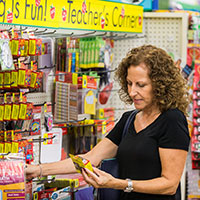 Teachers often spend own money for classroom supplies
Teachers often spend own money for classroom supplies
STORY
The Indian River County School District is flush with taxpayer funds. The district’s $287 million annual budget allows it to squander millions on ill-advised and fruitless legal battles and pays for administrators’ stays at Waldorf Astoria hotels when they attend out-of-town meetings.
But for some reason, there doesn't seem to be enough money for classroom supplies. Elementary school teachers routinely spend hundreds of dollars of their own money to pay for things they need for their rooms and students.
These teachers spent much of last summer gathering the supplies they knew they would need this fall; and their spending will continue throughout the school year as they strive to keep their kids engaged and interested.
Nearly all of them have dipped into their own pockets again and again, each spending as much as $500 to support their individual teaching methods and meet state requirements.
Third-grade teacher Debbie Irish says this phenomenon “is definitely happening to everybody, every year.”
Superintendent Mark Rendell just proposed another raise for school administrators, but the teachers’ plight has gotten so bad that some are now trying “go fund me” type efforts on Facebook to get the money they need to properly equip their classrooms.
What sorts of supplies are teachers willing to buy with their own money?
Notebooks, markers and pillows. Also, marshmallows and Oreos. These might sound like frivolous “school supplies,” but when grade-school teachers are trying to instruct fidgety, easily-distracted kids, the iconic cookies and other humble items can become serious teaching tools.
During the summer, elementary school teachers prepare not only their materials, but also their classroom environments. Second-grade teacher Janet Olsson created a reading nook with pillows (not chairs), “a cozy place, to encourage reading,” spending “$20 here, $20 there” on cushions and other nook supplies.
To comply with certain Common Core requirements, Olsson also purchased pocket binders, tabs and notebooks for each classroom “station.”
At the beginning of each school year, teachers send parents a list of basic supplies to provide for their child, but families can't always afford to buy enough for the entire school year. This, Irish says, is a big problem in Title I schools (those with at least 40 percent low-income students). “We feel bad,” she said.
“They should have the same supplies as the other students. I spent $100 myself,” buying materials kids’ families could not afford.
This year, the state-required recess period was increased to 40 minutes, 20 of which must be “structured play,” says Irish. In order to keep a playground full of energetic kids focused, items like soccer balls, basketballs and Frisbees are needed, and teachers end up paying for them.
“They love the balls,” Irish says. “We can't keep playing duck-duck-goose for 20 minutes.”
Fourth-grade teacher Lisa Skinnider stocks up on tchotchkes as rewards for good behavior. “While students should be intrinsically motivated, they also need positive reinforcement,” she says.
The personal funds elementary teachers pull from their own paychecks are over and above the $252 they receive for supplies from the Florida Teachers Classroom Supply Assistance Program and other sources that include private donations and grants from the Education Foundation of Indian River County, which was created to fill funding gaps within the School District.








